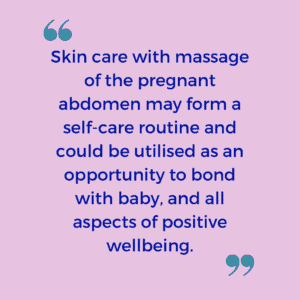Skin Care During Pregnancy
By Hannah Horne
Midwife, Hypnobirthing and Wellbeing Practitioner
Instagram @birth_wellbeing_midwife
Summary
There are many changes to the body during pregnancy. Skin care in pregnancy is arguably one of the lesser prioritised health topics discussed during antenatal care – yet it is important and here we explore why.
The skin covers the external surface of the body and is the largest organ, acting as a protective barrier against environmental stressors.1 Other physiological functions include thermoregulation, sensation, water storage, homeostatic maintenance, vitamin synthesis, absorption and emotional expression.2 Given these vital functions skin integrity should be prioritised in pregnancy.
Common skin changes include darkening areas on breasts, nipples or inner thighs, melasma on the face, linea nigra on the abdomen, stretch marks, acne and varicose veins.3
Skin changes during pregnancy are due to hormones and pregnancy physiology. Some pre-existing skin conditions are possibly being more difficult to treat, with some treatments contraindicated.4
There is no reference to specific advice regarding skin care in the current NICE Antenatal Care Guideline,5 however skin conditions may be associated with itching which needs further consideration.
Itching in pregnancy without a rash may be due to intrahepatic cholestasis of pregnancy, whereas itching with a rash may be due to polymorphic or atopic eruption of pregnancy or pemphigoid gestationis, all of which need appropriate testing diagnosis and treatment, given potential impact on the baby.6

Stretch marks are often a concern for pregnant women, with research on topical products being limited, yet the medium of massage has shown to have positive results for improving scar tissue.7
With regard to most general skin conditions, pregnant women and people can use their usual skin-care products; a literature review reported these are not expected to increase risks to the developing baby.8
The UK government holds regulations for cosmetic product safety9 which is reassuring. Skin-care products for use in pregnancy that use natural, holistic products which respect the environment are available.
These can contribute to health and wellbeing, through maintenance of good hygiene of the skin’s protective barrier, using moisturisers to ease skin change-related symptoms, plus use of sunscreen to prevent skin cancer and reduce symptoms of skin colour changes. Skin care with massage of the pregnant abdomen may form a self-care routine and could be utilised as an opportunity to bond with baby, and all aspects of positive wellbeing.
References
- Lopez-Ojeda W, Pandey A, Alhajj AM, Oakley, AM. Anatomy, Skin (Integument). In: StatPearls [Internet]. Treasure Island (FL). 2022.
- McKnight G, Shah J, Hargest R. Physiology of the skin. Basic Science. 2022;40(1):8-12. doi.org/10.1016/j.mpsur.2021.11.005.
- Skin Conditions During Pregnancy. ACOG https://www.acog.org/womens-health/faqs/skin-conditions-during-pregnancy. Updated July, 2022. Accessed December 07, 2022.
- Putra IB, Jusuf NK, Dewi NK. Skin Changes and Safety of Topical Products During Pregnancy. J Clin Aesthet Dermatol. 2022;15(2):49-57.
- Antenatal Care NICE Guideline [NG201]. NICE. https://www.nice.org.uk/guidance/ng201/chapter/recommendations. Published August 19, 2021. Accessed December 07, 2022.
- Itch in Pregnancy. NICE. https://cks.nice.org.uk/topics/itch-in-pregnancy/. Updated April, 2020. Accessed December 07, 2022.
- Ud-Din S, McGeorge D, Bayat A. Topical management of striae distensae (stretch marks): prevention and therapy of striae rubrae and albae. J Eur Acad Dermatol Venereol. 2015;30(2):211-222. doi.org/10.1111/jdv.13223.
- Bozzo P, Chua-Gocheco A, Einarson A. Safety of skin care products during pregnancy. Can Fam Physician. 2011;57(6):665-667.
- Statutory Guidance: Regulation 2009/1223 and the Cosmetic Products Enforcement Regulations 2013: Great Britain. GOV.UK. https://www.gov.uk/ government/publications/cosmetic-products-enforcement-regulations-2013/regulation-20091223-and-the-cosmetic-products-enforcement-regulations- 2013-great-britain#chapter-ii–safety-responsibility–freemovement. Updated November, 2022. Accessed December 07, 2022.










